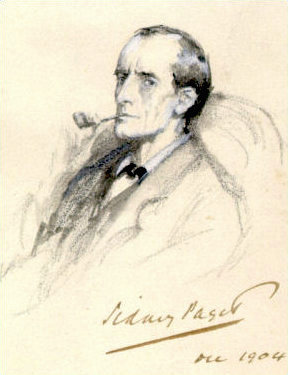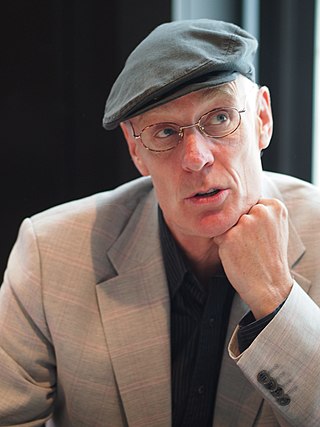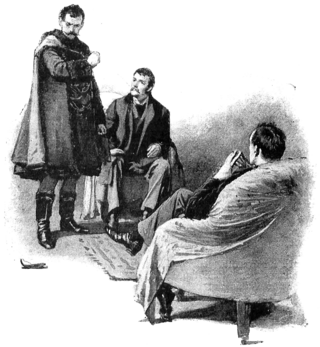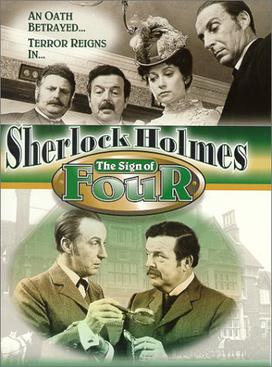
Sherlock Holmes is a fictional detective created by British author Arthur Conan Doyle. Referring to himself as a "consulting detective" in his stories, Holmes is known for his proficiency with observation, deduction, forensic science and logical reasoning that borders on the fantastic, which he employs when investigating cases for a wide variety of clients, including Scotland Yard.

Matthew George Frewer is a Canadian-American actor and comedian. He portrayed the 1980s icon Max Headroom in the 1985 TV film and 1987 television series of the same names.

The Sign of the Four, also called The Sign of Four, is an 1890 detective novel, and it is the second novel featuring Sherlock Holmes by British writer Sir Arthur Conan Doyle. Doyle wrote four novels and 56 short stories featuring the fictional detective.

"A Scandal in Bohemia" is the first short story, and the third overall work, featuring Arthur Conan Doyle's fictional detective Sherlock Holmes. It is the first of the 56 Holmes short stories written by Doyle and the first of 38 Sherlock Holmes works illustrated by Sidney Paget. The story is notable for introducing the character of Irene Adler, who is one of the most notable female characters in the Sherlock Holmes series, despite appearing in only one story. Doyle ranked "A Scandal in Bohemia" fifth in his list of his twelve favourite Holmes stories.

"The Adventure of the Bruce-Partington Plans" is one of the 56 Sherlock Holmes short stories written by Sir Arthur Conan Doyle. It is one of eight stories in the cycle collected as His Last Bow (1917), and is the second and final main appearance of Mycroft Holmes. It was originally published in The Strand Magazine in the United Kingdom and in Collier's in the United States in 1908.
Kenneth Clifford Welsh, was a Canadian actor, who made over 300 stage, film, and television appearances over a nearly 60-year career.
Clive Merrison is a Welsh actor of film, television, stage and radio. He trained at Rose Bruford College. He is best known for his long running BBC Radio portrayal of Sherlock Holmes, having played the part in all 64 episodes of the 1989–1998 series of Sherlock Holmes dramatisations, and all 16 episodes of The Further Adventures of Sherlock Holmes (2002–2010).
The stories of Sherlock Holmes by Sir Arthur Conan Doyle have been very popular as adaptations for the stage, and later film, and still later television. The four volumes of the Universal Sherlock Holmes (1995) compiled by Ronald B. De Waal lists over 25,000 Holmes-related productions and products. They include the original writings, "together with the translations of these tales into sixty-three languages, plus Braille and shorthand, the writings about the Writings or higher criticism, writings about Sherlockians and their societies, memorials and memorabilia, games, puzzles and quizzes, phonograph records, audio and video tapes, compact discs, laser discs, ballets, films, musicals, operettas, oratorios, plays, radio and television programs, parodies and pastiches, children's books, cartoons, comics, and a multitude of other items — from advertisements to wine — that have accumulated throughout the world on the two most famous characters in literature."
Sherlock Holmes has long been a popular character for pastiche, Holmes-related work by authors and creators other than Arthur Conan Doyle. Their works can be grouped into four broad categories:
The Sign of Four may refer to:

The Ulster is a Victorian working daytime overcoat, with a cape and sleeves.

The Sign of Four is a 1932 British crime film directed by Graham Cutts and starring Arthur Wontner, Ian Hunter and Graham Soutten. The film is based on Arthur Conan Doyle's second Sherlock Holmes novel The Sign of the Four (1890). The film is also known as The Sign of Four: Sherlock Holmes' Greatest Case.
The Case of the Whitechapel Vampire is a non-canonical Sherlock Holmes film. The film was produced in 2002 for The Hallmark Channel as the last installment in a series of Hallmark Sherlock Holmes films.
This article describes minor characters from the Sherlock Holmes stories by Sir Arthur Conan Doyle, and from non-canonical derived works. The list excludes the titular character as well as Dr. Watson, Professor Moriarty, Inspector Lestrade, Mycroft Holmes, Mrs. Hudson, Irene Adler, Colonel Moran, the Baker Street Irregulars, and characters not significant enough to mention.

The Sign of Four is a 1983 British made-for-television mystery film directed by Desmond Davis and starring Ian Richardson and David Healy. The film is based on Sir Arthur Conan Doyle's 1890 novel of the same name, the second novel to feature Sherlock Holmes and Doctor Watson.
The Hound of the Baskervilles is a Canadian television film directed by Rodney Gibbons and starring Matt Frewer and Kenneth Welsh. The film is based on Arthur Conan Doyle's 1902 Sherlock Holmes novel of the same name.
The Royal Scandal is a Sherlock Holmes film which is an amalgam of "A Scandal in Bohemia" and "The Bruce-Partington Plans". The film was produced in 2001 for The Hallmark Channel as part of an ongoing series of Hallmark Sherlock Holmes films.
The Sign of Four is a 1923 British silent mystery film directed by Maurice Elvey and starring Eille Norwood, Isobel Elsom and Fred Raynham. The film is based on the 1890 novel The Sign of the Four by Arthur Conan Doyle, and was one of a series of Sherlock Holmes films starring Norwood.
The Hound of the Baskervilles is the third of four Sherlock Holmes novels written by Sir Arthur Conan Doyle.







